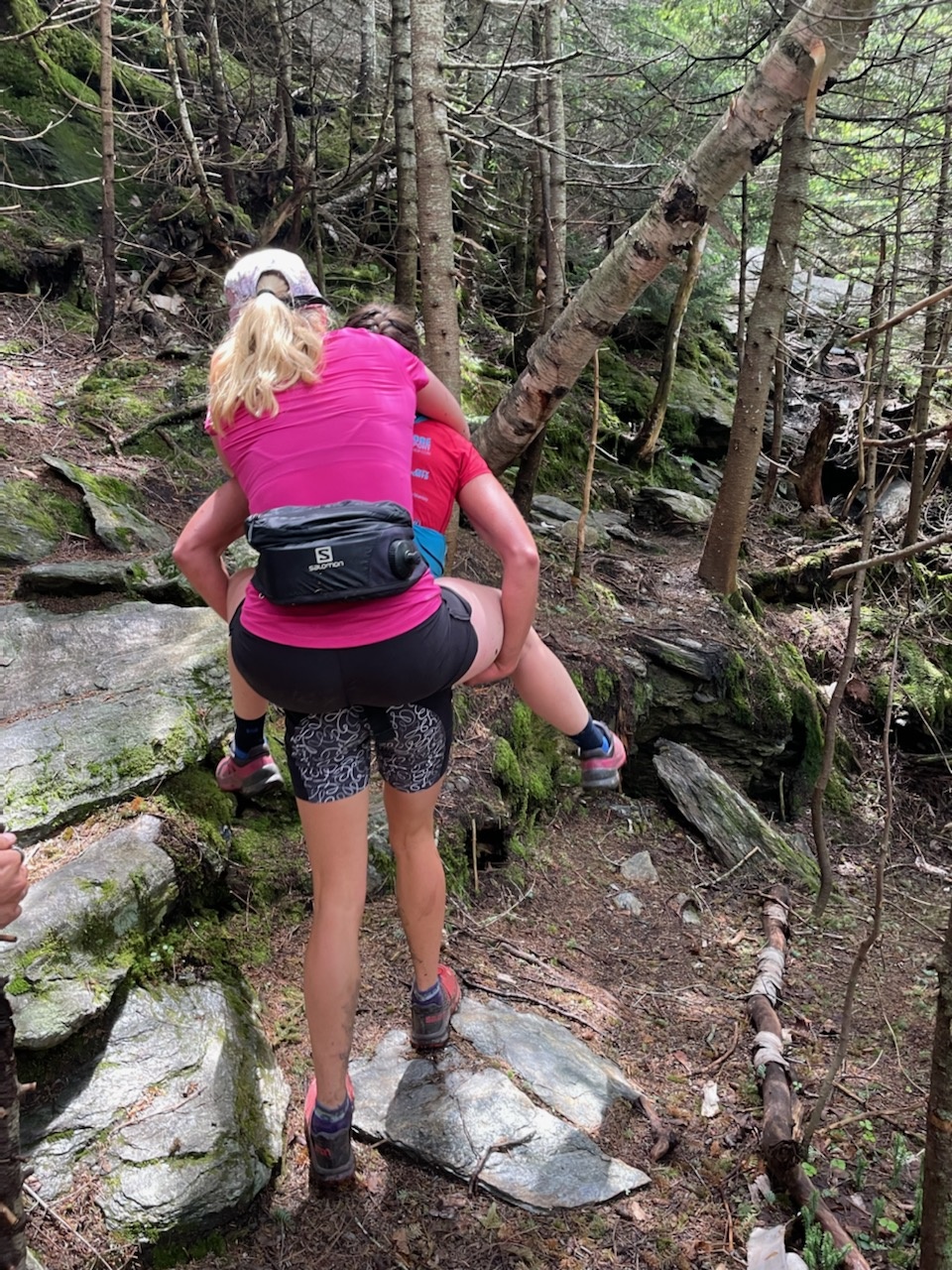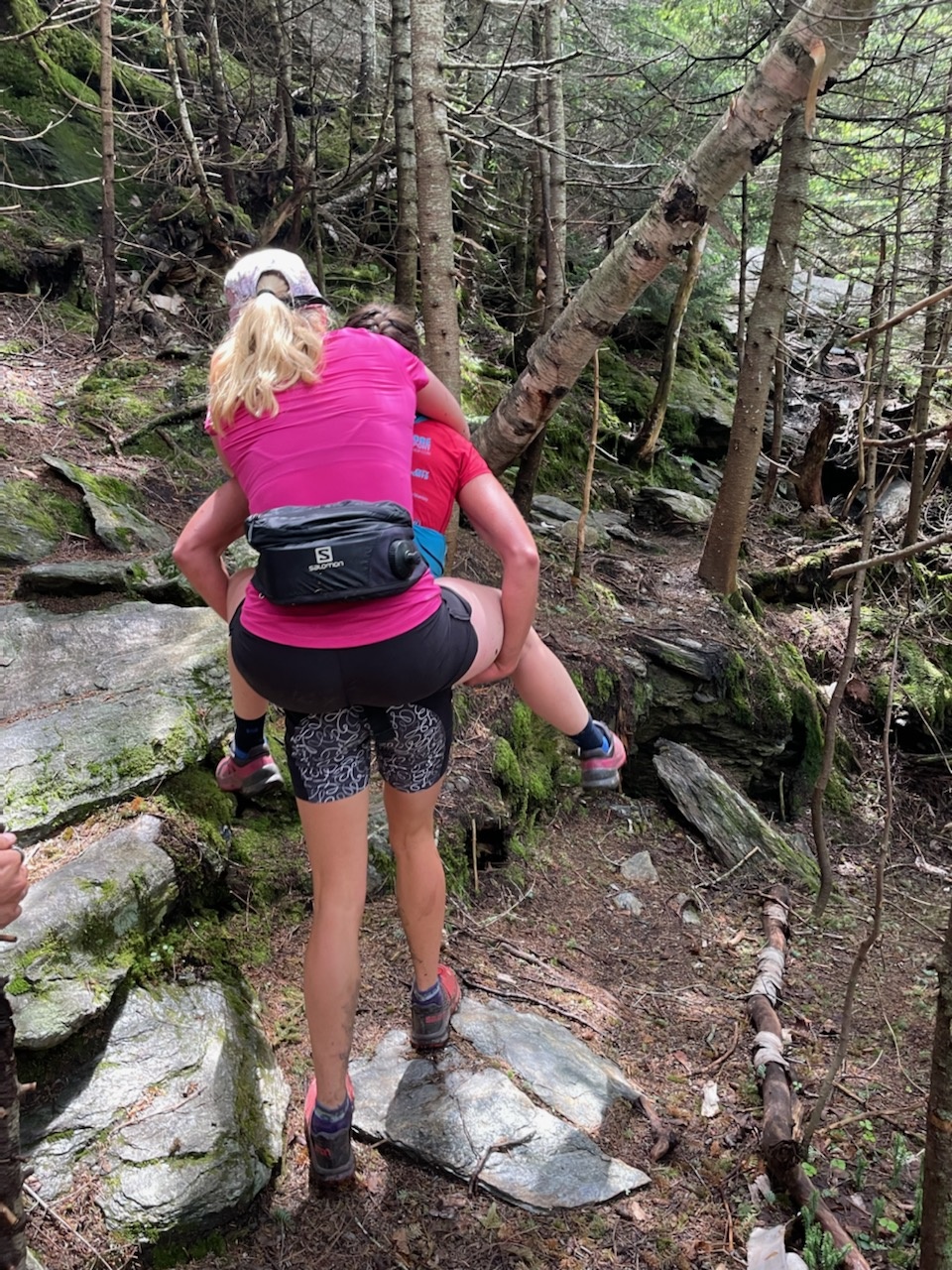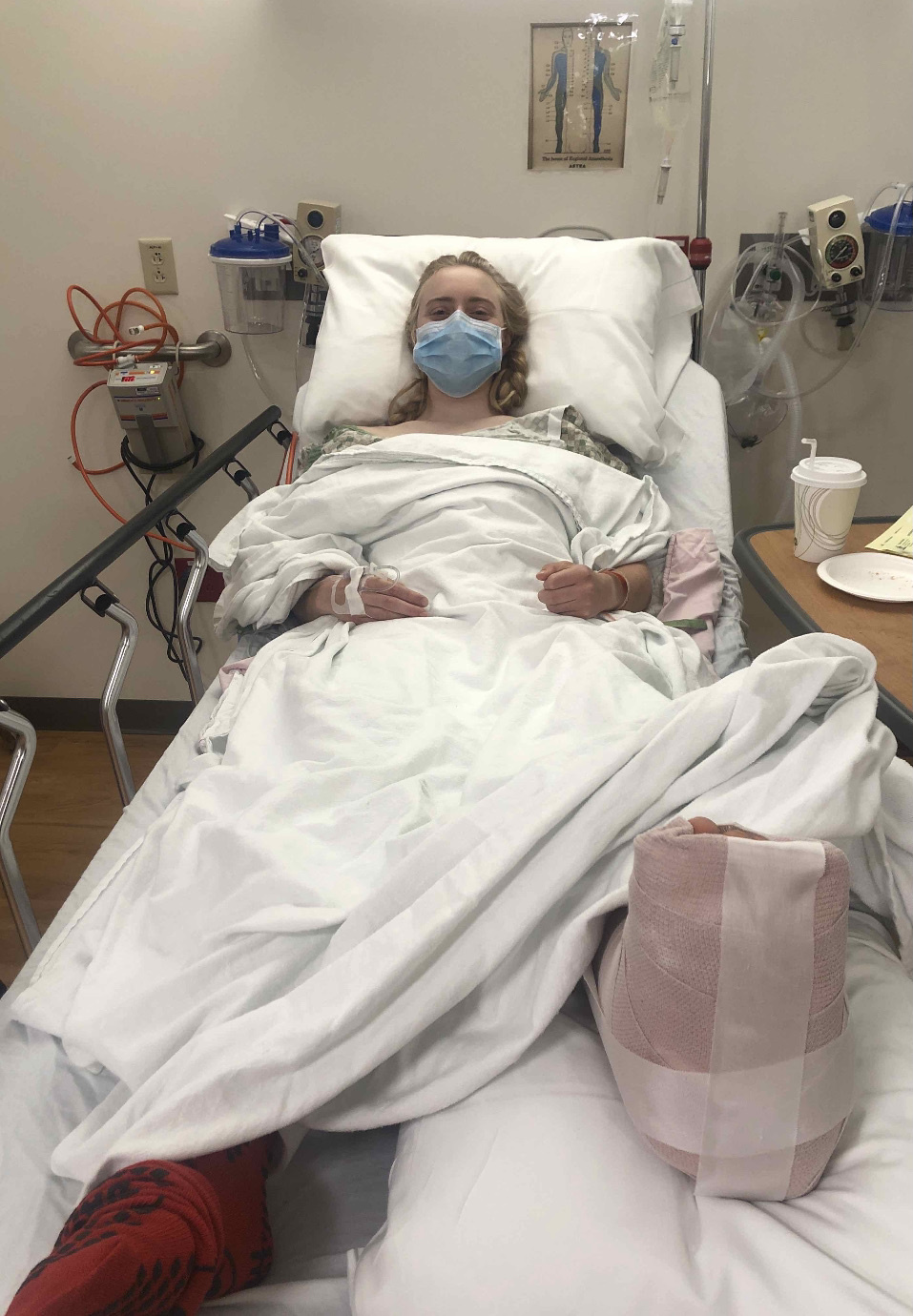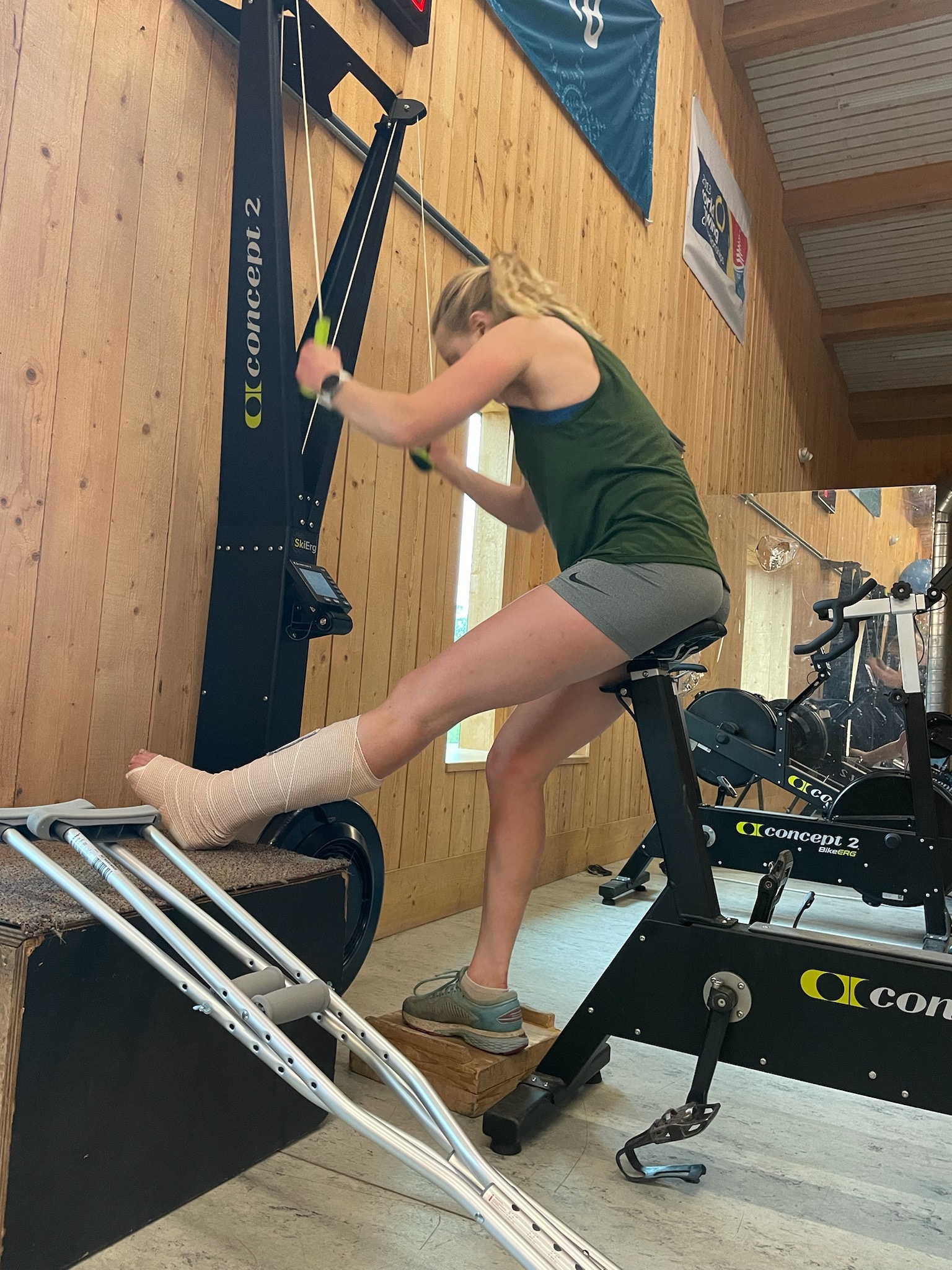Summer Training and Bad Breaks - Michaela Keller-Miller
- Posted on
- By Michaela Keller-Miller
- Posted in Sponsored Athletes

Summer training is well underway, bringing its fair share of long training sessions, intervals, post-workout tiredness, and an obstacle or two to keep life interesting. Here in Northern Vermont, my summer started off strong as my Green Racing Project teammates and I began ramping up the training hours, fine-tuning technique, and pushing hard interval sets. As cross country skiers, it’s of course preferable to avoid any summer training hitches, be that injury, sickness, or overtraining. Skiers are intent on building fitness in a never-ending upward trajectory. However, skiing rarely follows a linear progression and factors outside of our control can throw a wrench in even the most meticulously laid training plans. While there is never an opportune time to get injured or sick, looking at a setback as an opportunity to work on weaknesses and mental toughness can help you come back stronger and more prepared for the race season ahead.
May and June are typically great months to build training volume back up by adding in several distance and over-distance workouts roller skiing, running, or biking. As race season is still months away, skiers can train more hours and risk mild fatigue as there is no need to be fresh for races and there is time to recover properly. Ski training offers flexibility, as not every workout has to be on rollerskis. In fact, mixing up the training method helps to keep your body fresh and adds variety to what could otherwise turn monotonous. One of my favorite summer workouts is simply a long trail or gravel road run. Another personal favorite is L3 skate intervals, as these are one of the best ways to focus on technique. L3 intervals allow you to practice technique at a higher speed without being overly gassed as you would be during higher intensity intervals.
In an ideal world, summer would continue on with a series of training cycles, gradually increasing the volume and intensity from one cycle to the next. However, as I mentioned, summer training wouldn’t be complete without a hurdle or two to clear.
After starting the summer with an injured calf muscle, I was finally back to running with my team when I slipped on a wet rock on the Long Trail in Vermont. At that point, we were nearly three hours into the run and still about two miles from the road. At first, I thought I had twisted my ankle and could hobble back with the help of my GRP teammates. After gingerly attempting to take a few steps, I realized that I might be in over my head and resorted to hopping on my right foot down the rocky and rooted trail. From there, my teammates stepped in and took turns piggybacking me down the rest of the mountain, taking care to avoid steep drops where I would instead scoot and one-legged hop my way over the obstacle. My teammates gave a much more literal meaning to the phrase ‘carrying a teammate through the workout’ that day, and I am so grateful to be surrounded by such an incredible and inspiring group of people.

The following morning, I finally made it to urgent care and what I had originally thought was just a sprained ankle turned out to be a broken bone requiring surgery to repair. When you’re a full-time ski racer used to training twice a day, it’s easy to immediately begin stressing about what this means for the upcoming race season. Injuries can be difficult to navigate and frustrating when they create uncertainty and limit training options. As my broken ankle put me on crutches for the second time in less than two years, I was certainly feeling disappointed.
While it’s totally valid and normal to take time to process and cope, it’s also a great opportunity to take a step back and look at the big picture. In my case, I knew that I’d successfully cross trained before; after breaking my foot the August before my senior year at the University of Alaska Anchorage, I managed to pull off my best results at US Nationals to date. Taking a positive approach to injuries can be difficult, but looking for silver linings and finding creative ways to stay active have been crucial in my approach to injury recovery.

Immediately following the ankle break, I had to wait almost two weeks for the swelling to go down before I could get surgery to put my ankle bones back in place. As I couldn’t put any weight on my left leg and had to keep my leg elevated to reduce the swelling, I found myself SkiErging in a sitting position for over two hours at a time, going for distance kayaks, and tacking on daily core sessions. While sitting SkiErg and kayaking would typically not be included in my training arsenal, they proved to be effective ways to stay sane and maintain fitness.

Though injury cross training is indisputably lonelier and less exciting than “normal” ski training, I’ve worked to stay positive by altering my mindset and looking for the opportunities that only an injury can provide:
· First and foremost, injuries happen. There’s no point in replaying the ‘what ifs’ in your head and giving yourself a hard time for being injured. It’s better to focus on what you can do in the meantime to rest, keep up the alternative training, and recover.
· Injuries are oftentimes a great chance to work on your weaknesses. Earlier this summer, I had been focusing on more efficient double poling, so my new training limitations allowed me to see the SkiErg as an opportunity to improve my double pole rather than as a gym death sentence.
· Undoubtedly, being injured isn’t always fun. The act of keeping a positive headspace and working on mental toughness will work out in your favor come winter when you need to dig deep in a race. Searching for ways to stay focused on working hard helps to keep me encouraged that I will return from injury stronger than before.
· Acknowledge that it is very unlikely that a single injury will unravel your training! It’s important to keep in mind that you were training hard before the injury happened, so you already have a strong base that will carry you through. As long as you find ways to stay fit given your injury limitations, you will maintain a high level of fitness.
· Rest is always important but allowing yourself a break is especially crucial to recovering properly from injury. As frustrating as it may be to lower training hours and the number of intensity sessions, injuries place added stress on your body so it’s normal to make training adjustments. Injuries also take away the variety of ski training methods which can lead to muscle fatigue more quickly. Be honest with yourself and don’t force yourself to work out if your body is signaling that you need rest.
· There’s no “ideal” training schedule. Hard work is hard work whether you’re stuck inside spin biking or doing typical summer ski training. Keep working on components
important to skiing, such as visualizing a ski race while doing spin bike intervals or reminding yourself of technique cues while double poling on a SkiErg.
· Lastly, I take injuries day by day. It’s easy to get discouraged when I think too far ahead or about how many weeks I have left until I’m back to skiing and running again. I focus on and invest my full energy into one workout at a time, trying my best to reset each day. That’s not to say I don’t keep the big picture in mind when I’m training. I continually remind myself that putting in hard work now, however difficult it may be, will be rewarding come ski season. As I get closer to being able to add in new training activities, I allow myself to look forward and use that as motivation to train hard so that the transition back to normal activities will be as smooth as possible.
Although it will likely be some time before I’m back to normal ski training again, all is not lost as far as summer training goes. As I currently lay on the couch, elevating my leg and recovering from surgery, I think ahead to what is possible in terms of training. I’ve been fortunate to have access to SkiErgs, kayaks, and a wonderfully supportive community at the Craftsbury Outdoor Center. Once I’ve given my body enough time to recover from surgery, I’m confident I will be back sit SkiErging and kayaking until my arms turn to jelly. Even though I can’t control a broken ankle, I can do my best to deal with the hand I’ve been dealt. Until I’m back on my feet, you can find me in the gym or on the couch, balancing hard work and rest and taking recovery one day at a time.
